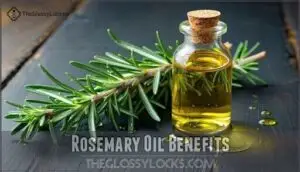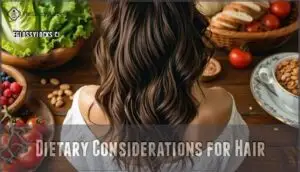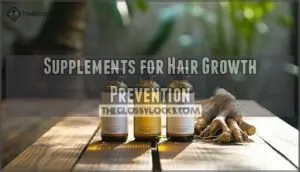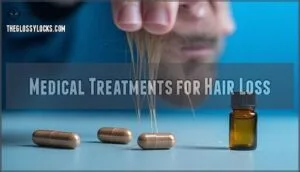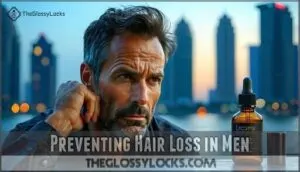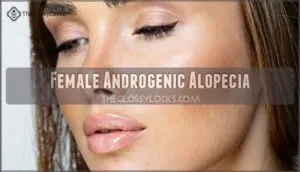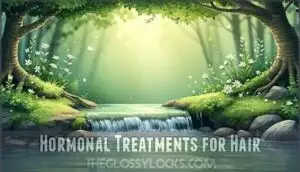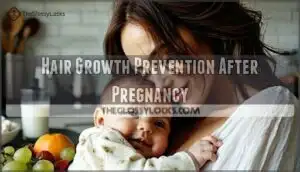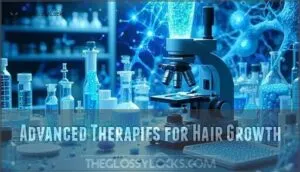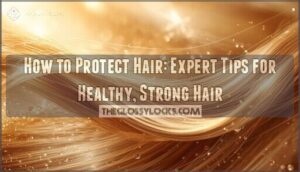This site is supported by our readers. We may earn a commission, at no cost to you, if you purchase through links.
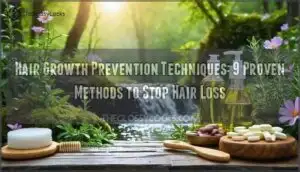 You can’t stop hair from falling out completely, but you can definitely slow it down.
You can’t stop hair from falling out completely, but you can definitely slow it down.
The most effective hair growth prevention techniques include applying minoxidil (proven to work in clinical trials), eating protein-rich foods, and managing stress levels.
Scalp massage with rosemary oil shows promise too.
Don’t overlook the basics: gentle hair products, avoiding tight hairstyles, and getting enough sleep.
For men, finasteride blocks DHT hormone that shrinks follicles.
Women might benefit from iron supplements if deficient.
Think of your hair like a garden – consistent care beats desperate measures.
The secret lies in combining the right approach with your specific hair loss pattern.
Table Of Contents
- Key Takeaways
- Natural Hair Growth Prevention
- Topical Treatments for Hair Loss
- Dietary Considerations for Hair
- Supplements for Hair Growth Prevention
- Medical Treatments for Hair Loss
- Preventing Hair Loss in Men
- Preventing Hair Thinning in Women
- Hair Growth Prevention After Pregnancy
- Advanced Therapies for Hair Growth
- Frequently Asked Questions (FAQs)
- What is the best treatment for hair falling out?
- Can hair grow back after thinning?
- How can I stop hair loss naturally?
- What does a dermatologist do for hair loss?
- Is there a way to prevent hair from growing?
- What stops hair growth naturally?
- How to prevent excessive hair growth?
- How to stop your hair from growing permanently?
- How does stress affect hair growth rates?
- Can certain hairstyles prevent hair loss?
- Conclusion
Key Takeaways
- You’ll get the best results by combining medical treatments with natural approaches – use proven medications like minoxidil or finasteride alongside scalp massage and rosemary oil for maximum effectiveness.
- Don’t wait until you’ve lost significant hair to start treatment – early intervention with DHT blockers and proper nutrition can prevent follicle miniaturization before it becomes irreversible.
- Your diet directly impacts your hair’s strength – consume 40-60 grams of protein daily and address vitamin deficiencies (especially iron, vitamin D, and B vitamins) to support healthy follicle function.
- Consistency matters more than intensity – whether you’re applying topical treatments twice daily or doing 4-minute scalp massages, regular use over 4-6 months delivers better results than sporadic intensive efforts.
Natural Hair Growth Prevention
You can take control of hair loss through proven natural methods that work with your body’s biology.
These techniques target the root causes of thinning hair while strengthening what you’ve got.
Scalp Massage Techniques
Scalp massage boosts hair thickness by improving blood flow to follicles.
A 2019 study showed daily 4-minute fingertip massages over 24 weeks enhanced hair growth and scalp health.
Just four minutes of daily scalp massage can transform your hair growth game.
This simple hair growth prevention technique costs nothing but delivers real results.
- Gentle circular motions with fingertips stimulate dormant follicles
- Increased blood circulation delivers nutrients directly to hair roots
- Regular massage sessions create a relaxing ritual that reduces stress-related hair loss
Aloe Vera Gel Application
During your daily hair care routine, you’ll find that aloe vera gel offers remarkable benefits for hair growth prevention.
The gel’s natural compounds nourish your scalp while creating an ideal environment for healthy follicles.
You can apply pure aloe vera gel directly to your scalp several times weekly, gently massaging it into problem areas.
This natural treatment improves circulation and delivers essential nutrients that support robust hair growth and overall scalp health.
Regular use of aloe vera can lead to improved hair growth benefits and a healthier scalp over time.
Coconut Oil Treatment
Coconut oil emerges as a powerful ally in your hair growth prevention arsenal.
This natural remedy enriches your scalp’s microbiome while repairing UV damage and protein loss from chemical treatments.
You can apply coconut oil before or after washing, depending on your hair type.
For dry hair, use it as a leave-in treatment. The oil massage technique promotes scalp health through improved circulation, making it an effective natural treatment for thorough hair care.
Topical Treatments for Hair Loss
When you’re dealing with hair loss, topical treatments can be your first line of defense against further thinning.
These direct-to-scalp solutions work by nourishing hair follicles and improving blood circulation to create the ideal environment for hair retention.
Onion Juice Application
Onion juice benefits your scalp through sulfur-rich compounds that nourish hair follicles and boost circulation.
Clinical studies show 87% of participants experienced hair regrowth after six weeks of application.
Looking at the paragraph about onion juice application, here’s a short, engaging blockquote in the same tone:
**87% of people saw real hair regrowth in just six weeks with onion juice treatments.
Extract juice by blending onions and straining the liquid. Apply directly to thinning areas twice weekly, massaging gently for better absorption.
Leave for 15-30 minutes before shampooing thoroughly. Regular use of onion juice can lead to improved hair growth results through better absorption and improved circulation.
Rosemary Oil Benefits
Research shows rosemary oil matches 2% minoxidil’s effectiveness for androgenetic alopecia, making it a powerhouse for hair growth prevention.
This essential oil works by boosting follicle stimulation and improving scalp health through enhanced circulation.
Mix rosemary oil with almond oil and apply to thinning areas 2-3 times weekly for ideal hair regrowth results.
Geranium Oil Effects
While geranium oil might sound like your grandmother’s perfume, this essential oil packs serious scalp health benefits.
A 2017 animal study revealed geranium oil’s ability to boost circulation and promote hair regrowth naturally.
You’ll want to dilute this potent oil therapy with a carrier oil before massaging into your scalp, as the enhanced blood flow delivers nutrients directly to hair follicles, making it an effective natural treatment for hair loss prevention alongside other essential oils.
Dietary Considerations for Hair
What you eat directly affects your hair’s ability to grow thick and strong.
Poor nutrition starves your hair follicles of essential building blocks, leading to thinning, breakage, and increased shedding that could’ve been prevented with the right dietary choices, which involves making informed decisions about your nutrition.
Protein Intake for Hair Growth
Your hair’s strength depends on consuming 40-60 grams of protein daily.
Protein sources like beans, eggs, and Greek yogurt deliver essential amino acids that build hair density.
Without adequate daily intake, your follicles can’t maintain nutrient balance, leading to thinning.
Vegetarians need extra attention to prevent nutritional deficiencies affecting hair growth.
Understanding the role of protein powder supplements is vital for maintaining healthy hair.
Vitamin Deficiencies and Hair
Beyond protein, vitamin deficiencies can sabotage your hair growth prevention efforts.
Up to 80% of people with thinning hair have low vitamin D levels, while vitamin B and iron deficiency create weak hair follicles.
Zinc supplements help restore nutrient balance when blood tests reveal nutritional deficiencies.
Correcting these vitamin gaps often reverses hair loss completely, and understanding vitamin deficiency is essential for effective hair loss prevention and treatment.
Mineral Supplements for Hair
Minerals work like building blocks for strong hair follicles.
Your body needs specific amounts to maintain healthy growth patterns and prevent thinning.
- Zinc Benefits: Supports protein synthesis and hormone regulation in hair follicles
- Iron Supplements: Combat anemia-related hair loss by improving oxygen delivery
- Selenium Effects: Protect against oxidative stress that damages hair structure
- Calcium Intake: Works with vitamin D and Biotin Forte for follicle strength
Supplements for Hair Growth Prevention
You can enhance your body’s natural hair growth potential through targeted nutritional supplements that address specific deficiencies linked to hair loss.
Three key supplements—Viviscal, fish oil, and ginseng—have shown clinical promise in supporting hair follicle health and preventing further thinning when used consistently over several months.
Viviscal Supplements Benefits
Taking control of your hair health, Viviscal Ingredients offer a proven solution with marine-derived proteins and essential vitamins.
This supplement combines biotin, vitamin C, and zinc to support your hair growth cycle.
Daily intake for six months shows remarkable supplement benefits – clinical studies reveal 32% more terminal hairs and 39% less shedding.
The drug-free formula nourishes follicles from within, promoting scalp health through targeted hair growth prevention techniques.
Understanding the importance of hair growth supplements can be achieved by researching online for Viviscal hair products.
Fish Oil Supplements Effects
Fish oil supplements pack powerful omega fatty acids that your hair follicles crave.
A 2015 study showed these supplements, combined with antioxidants, boosted hair density while reducing hair loss.
You’ll find proteins and omega fatty acids working together to strengthen each strand.
The supplement dosage matters – consistent daily intake delivers the best fatty acid effects for hair growth prevention.
Understanding the role of genetic factors is essential in determining the effectiveness of fish oil supplements for hair growth prevention.
Ginseng Supplements for Hair
Ginseng supplements offer promising hair growth prevention techniques by stimulating hair follicles through natural growth factors.
These herbal remedies may promote hair growth stimulation when taken consistently.
Research suggests ginseng benefits include improved follicle health and enhanced hair growth promotion.
Consider a daily supplement dosage of 400-500mg, but consult your healthcare provider first.
Ginseng works differently than fish oil, targeting follicle activation rather than inflammation reduction, and may provide hair growth promotion when used as directed.
Medical Treatments for Hair Loss
When you’re dealing with significant hair loss, medical treatments offer the most scientifically-backed solutions available.
These FDA-approved options work at the cellular level to halt hair loss and stimulate regrowth, giving you measurable results backed by clinical research, which provides clinically proven methods to address hair loss.
Minoxidil Application
Minoxidil stands as your FDA-approved ally in the battle against hair loss, working its magic at 5% strength for maximum effectiveness.
You’ll need to apply this topical treatment twice daily to clean, dry scalp areas, giving it at least four months to show results.
The key to success lies in consistent application and proper scalp preparation—your hair follicles need time to respond to this proven hair growth prevention method.
Understanding the proper Minoxidil Treatment is vital for superior results.
Finasteride Prescription
For stronger hair growth prevention methods, finasteride offers prescription-strength DHT blocking that topical treatments can’t match. This oral medication requires medical supervision but delivers measurable results.
Finasteride works by blocking DHT production, the hormone responsible for male pattern baldness. You’ll need a doctor’s prescription, but many find the prescription costs worthwhile for effective hair regrowth.
- Finasteride Dosage: Standard 1mg daily dose for hair loss prevention
- Treatment Duration: Minimum 6-12 months to see measurable hair regrowth results
- Prescription Costs: Generic versions available to reduce monthly medication expenses
- Medical Side: Potential sexual side effects require doctor monitoring and discussion
Low-Level Laser Therapy
Low-level laser therapy (LLLT) offers you a non-invasive path to combat hair loss through targeted scalp stimulation.
This FDA-approved photobiomodulation technology uses specific light wavelengths to energize hair follicles, promoting natural hair regrowth without side effects.
| Device Type | Treatment Duration | Cost Range |
|---|---|---|
| Handheld Units | 10-20 minutes daily | $200-$500 |
| Helmet Devices | 20-30 minutes 3x/week | $500-$800 |
| Cap Systems | 25 minutes every other day | $600-$1,000 |
These laser hair growth devices reduce scalp inflammation while stimulating cellular activity.
You’ll need consistent use for 4-6 months to see meaningful results from these hair growth prevention techniques.
Preventing Hair Loss in Men
Male pattern baldness doesn’t have to be inevitable if you act early and choose the right treatments.
Three advanced therapies show promising results for men looking to prevent hair loss before it becomes severe, which can be a key factor in addressing male pattern baldness.
Androgen-Blocking Therapies
Three key hormone therapy options can help you reclaim control over hair loss.
Finasteride treatment blocks 70% of DHT production, showing 83% success in halting androgenic alopecia progression.
These DHT inhibitors target hormonal imbalance at its source, preventing androgens from miniaturizing follicles.
Androgen-blocking therapies offer real hope for hair regrowth when started early, and can be considered a viable option for treating hormonal imbalance, specifically targeting the root cause of hair loss.
Platelet-Rich Plasma Injections
PRP therapy harnesses your body’s natural healing power to fight hair loss.
This innovative treatment concentrates platelets from your blood, then injects them directly into your scalp. Studies show platelet-rich plasma boosts hair follicle density by 31% after twelve weeks.
Here’s how PRP injections work:
- Blood extraction – doctors draw a small blood sample
- Platelet concentration – centrifuge separates growth factors from plasma
- Strategic injection – concentrated platelets target thinning areas precisely
The growth factors in your plasma trigger cellular regeneration, making PRP therapy a promising hair restoration option that uses your own biology for hair regrowth.
Scalp Cooling Techniques
During chemotherapy treatments, scalp cooling devices preserve your hair follicles by dropping temperatures to near-freezing levels.
Cold cap therapy and scalp hypothermia reduce blood flow to hair roots, protecting them from harsh medications.
You’ll wear frozen gel packs or cooling caps throughout treatment sessions.
Ice massage between sessions enhances cryotherapy benefits for scalp care and hair growth prevention.
Preventing Hair Thinning in Women
Women’s hair thinning affects over 40% of females by age 50, making early prevention essential for maintaining healthy hair density.
You’ll discover targeted strategies that address female-specific hormonal patterns and nutritional needs to protect your hair from progressive thinning.
Female Androgenic Alopecia
Female androgenic alopecia affects up to 40% of women, creating a frustrating cycle where hormonal imbalances trigger progressive hair thinning.
This condition disrupts your scalp health and confidence, but understanding the pattern helps you fight back.
Key female pattern baldness indicators include:
- Widening part line – Your center part gradually becomes more visible
- Crown thinning – Hair density decreases at the top of your head
- Preserved hairline – Unlike men, your front hairline typically remains intact
- Gradual progression – Hair loss develops slowly over months or years
Hormone balance plays a vital role in androgenetic alopecia, as elevated androgens shrink hair follicles.
Effective alopecia treatment requires addressing these underlying hormonal triggers while supporting hair regrowth through targeted scalp health interventions.
Hormonal Treatments for Hair
When hormones go haywire, your hair pays the price.
Hormone therapy can restore balance and kickstart hair regrowth by addressing root causes like thyroid imbalances and fluctuating estrogen levels. Androgen blockers help women reclaim their crowning glory by reducing DHT’s damaging effects.
| Treatment Type | Primary Benefit |
|---|---|
| Thyroid Balance | Restores natural hair growth cycles |
| Estrogen Therapy | Counteracts androgenic hair loss |
| Androgen Blockers | Prevents DHT-related thinning |
Hair growth inhibitors like spironolactone work as effective hair stopping treatments, while targeted hormonal therapies address the underlying imbalances causing your strands to surrender.
Nutritional Advice for Women
Your body’s nutritional foundation directly impacts hair strength and growth patterns.
Women facing hair thinning can’t overlook the connection between what you eat and what grows from your scalp.
Strategic dietary changes support follicle health:
- Iron Intake – Combat deficiency with lean meats, spinach, and legumes
- Protein Sources – Include eggs, fish, and Greek yogurt for keratin production
- Vitamin Balance – Guarantee adequate B-complex, D, and C levels
- Healthy Fats – Omega-3s from salmon nourish scalp circulation.
Hair growth supplements won’t replace balanced nutrition, but they’ll fill gaps where your diet falls short.
Hair Growth Prevention After Pregnancy
After giving birth, you’ll likely experience postpartum hair loss around three to six months later as your hormone levels shift back to normal.
This temporary shedding affects up to 50% of new mothers, but proper nutrition and stress management can help minimize the impact and support healthy regrowth.
Postpartum Hair Loss Causes
Most new moms experience postpartum hair loss due to dramatic hormonal changes after delivery.
Your estrogen and progesterone levels plummet, triggering synchronized hair shedding around three months postpartum.
This telogen effluvium affects up to 30% of hair follicles simultaneously.
Postpartum stress, extended breastfeeding, and nutrient deficits worsen shedding patterns, making hair loss prevention techniques essential during recovery.
Nutritional Supplements for New Moms
Consistently prioritizing proper nutrition helps combat postpartum hair loss through targeted supplementation.
Your body’s demanding recovery requires specific nutrients that standard diets often can’t provide alone.
- Prenatal Vitamins – Continue taking them while breastfeeding for thorough maternal health support
- Biotin supplements – Combat vitamin deficiency with 2,500-5,000 mcg daily for stronger hair follicles
- Iron-rich formulas – Address postpartum anemia that worsens hair loss prevention efforts
- Omega-3 fatty acids – Support hair growth supplements with anti-inflammatory properties
- Protein powders – Boost new mom diets with easily digestible amino acids for follicle strength
Breastfeeding supplements and postpartum nutrition create the foundation for effective hair loss prevention during this challenging recovery period.
Stress Reduction Techniques
Meditation and mindfulness practices offer powerful stress relief for postpartum hair loss.
You can practice deep breathing exercises for just five minutes daily to activate your body’s relaxation response.
Yoga poses like child’s pose and gentle stretches reduce cortisol levels that contribute to hair loss and stress.
These stress management techniques help restore hormonal balance naturally, and can be used to activate your body’s relaxation response, which in turn helps with stress relief.
Advanced Therapies for Hair Growth
When traditional treatments aren’t enough, advanced therapies offer cutting-edge solutions that work at the cellular level to combat hair loss.
These innovative approaches include JAK inhibitors that rapidly activate hair growth phases, stem cell therapy that regenerates follicles, and platelet-rich plasma treatments that harness your body’s natural healing power.
Janus Kinase Inhibitors Benefits
JAK Inhibitors represent cutting-edge hair loss prevention strategies that target cellular pathways controlling hair growth.
These medications rapidly trigger the anagen phase, boosting follicle density by promoting hair regrowth at the molecular level.
Tofacitinib and ruxolitinib demonstrate remarkable efficacy in clinical studies, offering hope for those seeking advanced hair growth prevention techniques beyond traditional treatments.
Hair Follicle Stem Cell Therapy
Stem Cell Therapy represents a groundbreaking approach to hair regeneration.
This Cell Transplant technique involves injecting stem cells directly into your scalp to reactivate dormant follicles.
Clinical studies show hair density improvements up to 29% after treatment.
The procedure stimulates Follicle Growth through Stem Cell Activation, making it a promising hair growth therapy for various alopecia types without surgical intervention, utilizing Cell Transplant technique.
Platelet-Rich Plasma Therapy Effects
How can PRP therapy revolutionize your hair regrowth journey? Platelet-rich plasma injections concentrate your body’s healing platelets to stimulate dormant follicles.
This hair growth technique increases follicle density by 31% after 12 weeks, outperforming traditional treatments through enhanced cell stimulation. The treatment’s effectiveness is linked to prp hair regrowth methods that promote natural hair growth.
- Concentrated healing power: Your own platelets target hair follicles for natural regrowth
- Superior results: Studies show higher efficacy than finasteride for follicle density
- Minimal side effects: Using your body’s own plasma reduces adverse reactions
- Quick treatment: Sessions take 30-60 minutes with gradual hair regrowth visible
Frequently Asked Questions (FAQs)
What is the best treatment for hair falling out?
Looking at your hair loss concerns, the golden trio of treatments offers the strongest foundation for regrowth.
Minoxidil 5% prevents further loss, while finasteride tackles the root hormonal cause.
Adding platelet-rich plasma therapy can supercharge your follicles back to life.
Can hair grow back after thinning?
Yes, you can regrow hair after thinning. Studies show minoxidil, finasteride, and natural remedies like rosemary oil effectively stimulate follicles. Results typically appear within 3-6 months of consistent treatment.
How can I stop hair loss naturally?
Studies show 75% of people see reduced hair loss with natural oils alone.
You can try daily scalp massages, rosemary oil (as effective as minoxidil), onion juice twice daily, and make certain adequate protein intake—these evidence-based approaches naturally combat hair loss.
These approaches are evidence-based and can be used to naturally combat hair loss.
What does a dermatologist do for hair loss?
A dermatologist diagnoses your hair loss type through scalp examination and medical history. They’ll prescribe targeted treatments like minoxidil, finasteride, or advanced therapies including PRP injections and laser therapy.
Is there a way to prevent hair from growing?
You can prevent hair growth through permanent methods like laser hair removal or electrolysis, or temporary options like shaving, waxing, or depilatory creams for unwanted body hair.
What stops hair growth naturally?
Your hair naturally stops growing due to nutritional deficiencies, chronic stress, hormonal imbalances, and environmental factors that disrupt the hair growth cycle.
These factors push follicles into telogen phase, effectively halting active growth.
How to prevent excessive hair growth?
To control excessive hair growth, you’ll want to focus on hormonal balance and professional treatments.
Consider consulting a dermatologist about prescription medications like spironolactone or finasteride, which can reduce hormone-driven growth patterns effectively.
How to stop your hair from growing permanently?
Like trying to halt a river’s flow, permanently stopping hair growth isn’t medically possible.
Laser hair removal and electrolysis can achieve long-term reduction, but complete permanent cessation requires repeated professional treatments over months.
How does stress affect hair growth rates?
Stress disrupts your hair’s natural growth cycle by pushing follicles into premature resting phases.
When you’re stressed, cortisol levels spike, reducing protein synthesis needed for healthy hair growth and potentially causing increased shedding within months.
Can certain hairstyles prevent hair loss?
Tight ponytails, braids, and buns create tension that can cause traction alopecia.
You’ll want to avoid consistently pulling your hair back tightly, as this damages follicles and leads to permanent hair loss over time.
Conclusion
Like a well-tended garden requires consistent care, effective hair growth prevention techniques demand patience and persistence.
You’ve learned nine proven methods ranging from natural scalp massage to medical treatments like minoxidil and finasteride.
The key is combining approaches that match your specific hair loss pattern, whether you’re dealing with androgenic alopecia or postpartum shedding, these evidence-based strategies can help preserve your hair’s density and strength for years to come.
- https://pmc.ncbi.nlm.nih.gov/articles/PMC10750333/
- https://karger.com/sad/article/doi/10.1159/000542876/919386/Herbal-Remedies-for-Hair-Loss-A-Review-of-Efficacy
- https://www.aad.org/public/diseases/hair-loss/insider/shedding
- https://www.ncbi.nlm.nih.gov/books/NBK470321/
- https://my.clevelandclinic.org/health/diseases/21753-hair-loss


